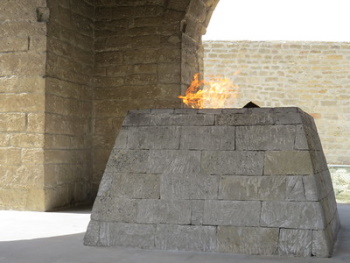Surakhany, Atashgyakh

Surakhany, Atashgyakh (Fire - worshippers, temple - museum at Surakhany) is part of the Tentative list of Azerbaijan in order to qualify for inclusion in the World Heritage List.
The Ateshgah (fire temple) at Surakhani is a 17th century former Zoroastrian sanctuary. It was a center of pilgrimage for Zoroastrians from the Indian subcontinent. The buildings, located around a courtyard, have several inscriptions in Sanskrit and Persian.
Map of Surakhany, Atashgyakh
Load mapThe coordinates shown for all tentative sites were produced as a community effort. They are not official and may change on inscription.
Community Reviews
Els Slots

Although some 85% of the current Azerbaijani population is Shi’a Muslim, Zoroasterianism still plays an important part in the image the nation presents to the outside world. After Azerbaijan's independence from Soviet Union, the phrase “Land of Fire” was coined as the slogan to promote the country as a tourist destination. It reflects both the natural burning of surface oil deposits and the oil-fueled fires in Zoroastrian temples. So it’s no wonder that one of these temples is on the country’s Tentative List: the Ateshgah at Surakhani.
According to this informative website about Zoroastrian heritage, the tradition of ‘fire-houses’ started with the development of community fire houses that housed an ever burning flame. The flame was kept going by professional fire keepers. Members of the community would light their house fires from the central community fire. These fire-houses later evolved into temples, which also served as solar observatories in order to fix dates for festivals.
The Ateshgah (“home of fire”) at Surakhani lies about half an hour outside of Baku. On the way out there we first visited Yanar Dag. This is a good appetizer for the actual fire temple, as it is a place where natural gas has been burning continuously since 1957. It’s an odd place, not much more than a small hill with multiple flames coming out of its base. This natural phenomenon once was more common in the Absheron peninsula (as this region is called), hence the attraction for Zoroastrians.
The fire temple at Surakhani nowadays is a popular tourist attraction. It is surrounded by a large complex that includes a restaurant, and there are ample parking spaces for tour buses. I visited on a Sunday, and there were many local tourists around.
There's only one entrance to the temple grounds. I read in a trip report from 1911 that this gate used to be adorned with inscriptions, a swastika emblem, a sun, four flowers and “several nondescript figures”. Now only the sun emblem is visible, positioned between possibly two lions, plus one inscription. When I asked for clarification, our Azerbaijani tour guide told that many of the original inscriptions and decorations had been shipped to Sint-Petersburg in Russia during the communist era.
The fire temple itself lies right in the middle of the inner courtyard, which also has a number of other burning flames. The courtyard is surrounded by a cloister of pilgrims’ cells. These have been turned into small exhibition rooms. It’s good to realize that this isn’t a temple anymore, it’s a museum (although people are free to worship if they want to). And even more anticlimatic: the structure that we see nowadays is a temple built by Hindu/Sikh immigrants in the 17th or 18th century. Zoroastrianism at that time had been eradicated already for some 10 centuries, after the conversion of this region to Islam. And the fires that burn in this courtyard are fed by a gas pipe from Baku…..
Zoroasterianism came to this region around 550 BC via the conquering Persian Achaemenid Empire. Now there are no Zoroastrians anymore in modern Azerbaijan, but the religion still has a hard-to-grasp cultural influence in the country. It may be largely symbolic (flames are everywhere in Baku, from the Flame Towers to the billboards announcing the next Baku Grand Prix), as well as folklore. The Ateshgah at Surakhani is another of these symbols. The Azerbaijani will get a hard time though explaining the authenticity of this site to an international audience for a future WH nomination.
Community Likes
Site Info
- Full Name
- Surakhany, Atashgyakh (Fire - worshippers, temple - museum at Surakhany)
- Country
- Azerbaijan
- Added
- 1998
- Type
- Cultural
- Categories
- Religious structure - Indigenous
- Link
- By ID
Site History
1998 Added to Tentative List
Site Links
Visitors
39 Community Members have visited.